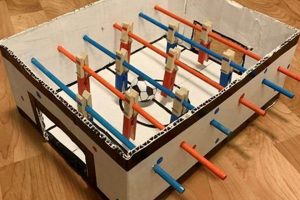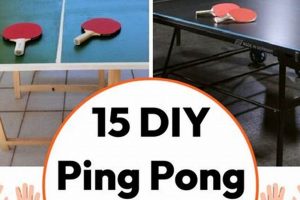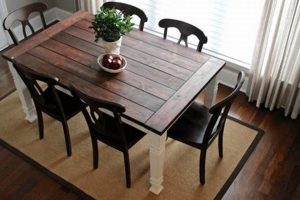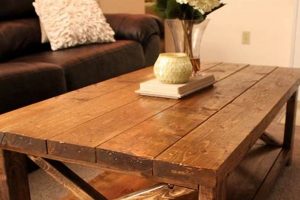The practice of constructing a workstation from individual components, often repurposing existing materials, represents an alternative to purchasing pre-fabricated furniture. This approach typically involves selecting a tabletop surface, such as a solid wood slab or a reclaimed door, and pairing it with legs or a supporting structure purchased separately or crafted from materials like metal pipes or wooden frames. The result is a customized workspace tailored to specific needs and aesthetic preferences.
Engaging in this type of construction offers several advantages. It can provide cost savings compared to purchasing new, mass-produced furniture. Furthermore, it allows for greater design flexibility, enabling the creation of a unique piece that perfectly fits the available space and complements the existing decor. Historically, individuals and small businesses have adopted this method to furnish workspaces according to specific functional requirements and budget constraints.
The subsequent discussion will explore various tabletop options, leg styles, construction techniques, and considerations for ergonomic design. This will provide practical guidance for individuals seeking to create a functional and aesthetically pleasing workstation through self-assembly and customization.
Office Table DIY
The construction of a custom workstation requires careful planning and execution. The following tips offer guidance on critical aspects of the building process.
Tip 1: Surface Material Selection. The tabletop material dictates the aesthetic and durability of the finished product. Solid wood offers a classic look and longevity, while laminate surfaces provide cost-effectiveness and ease of cleaning. Tempered glass offers a sleek, modern look, but requires careful handling during construction.
Tip 2: Structural Integrity. Secure and stable legs are paramount. Consider metal legs with adjustable feet for uneven floors or wooden frames with reinforced joints for added support. Proper weight distribution should be calculated based on anticipated load.
Tip 3: Ergonomic Height. A workstation height that promotes proper posture is essential for long-term comfort and health. A desk height of approximately 29-30 inches is suitable for individuals of average height. Consider adjustable-height legs for greater customization.
Tip 4: Cable Management. Incorporating cable management solutions during the build process prevents clutter and improves aesthetics. Consider grommets, trays, or adhesive clips to route cables neatly and safely.
Tip 5: Workspace Dimensions. Determine the optimal dimensions of the tabletop based on the intended use and available space. Ensure sufficient surface area for necessary equipment and comfortable working conditions.
Tip 6: Finishing and Protection. Apply a protective finish to the tabletop surface to enhance its appearance and prevent damage. For wood surfaces, consider polyurethane or varnish. For metal surfaces, powder coating provides a durable and attractive finish.
Tip 7: Tool Acquisition and Safety. Gather the necessary tools before commencing construction, including a drill, saw, measuring tape, and level. Prioritize safety by wearing appropriate protective gear, such as safety glasses and gloves.
Implementing these considerations will facilitate the creation of a functional, ergonomic, and aesthetically pleasing workstation that meets specific needs.
The subsequent section will delve into common challenges encountered during workstation construction and strategies for effective problem-solving.
1. Material Durability
Material durability is a fundamental consideration in the “office table diy” process. The selected materials directly impact the workstation’s lifespan, resistance to wear and tear, and overall suitability for its intended purpose. Inferior material selection inevitably leads to premature degradation, structural instability, and increased long-term costs associated with repair or replacement. For instance, utilizing softwood for a tabletop subject to heavy use will likely result in dents, scratches, and warping, while a more durable hardwood like oak or maple would exhibit greater resistance to such damage. Similarly, the choice of metal for legs influences the table’s load-bearing capacity and resistance to corrosion. A thin-gauge steel leg may buckle under heavy equipment, whereas a thicker gauge, powder-coated steel leg will provide significantly greater support and protection against rust.
The selection of durable materials extends beyond the primary structural components. The finish applied to the tabletop also contributes to its longevity. A robust polyurethane finish provides a protective barrier against spills, stains, and scratches, while a less durable finish, such as a simple varnish, may offer inadequate protection. Furthermore, the hardware used in the assembly process, such as screws and bolts, should be of high quality to prevent loosening or breakage over time. Neglecting these seemingly minor details can compromise the overall integrity of the workstation. Consider the example of a table constructed with particleboard and low-quality laminate. While initially appearing cost-effective, the particleboard is susceptible to moisture damage, causing swelling and delamination, while the laminate is prone to chipping and peeling. Consequently, the table’s lifespan is significantly reduced, necessitating earlier replacement.
In conclusion, prioritizing material durability is paramount in “office table diy” to ensure a long-lasting, functional, and aesthetically pleasing workstation. The careful selection of robust materials, appropriate finishes, and high-quality hardware directly contributes to the table’s structural integrity, resistance to damage, and overall value. While initially more expensive, investing in durable materials ultimately yields cost savings by minimizing the need for frequent repairs or replacements. The longevity of the workstation also promotes sustainability by reducing the demand for new resources and minimizing waste. Therefore, a thorough understanding of material properties and their impact on the workstation’s performance is crucial for a successful “office table diy” project.
2. Structural Stability
Structural stability is a paramount concern in the realm of “office table diy.” The capacity of a self-constructed or modified workstation to withstand applied loads and maintain its intended geometry directly influences its usability, safety, and longevity. Compromised stability can lead to functional limitations, potential hazards, and premature failure, rendering the workstation unsuitable for its intended purpose.
- Leg and Support Structure Design
The design and construction of the legs and supporting framework are critical determinants of structural stability. The choice of materials (e.g., steel, wood, or composite materials), the dimensions of individual members, and the methods of joinery all contribute to the table’s ability to resist bending, buckling, and shear forces. For example, inadequately sized wooden legs or poorly welded metal supports may exhibit excessive deflection under load, potentially leading to collapse. Conversely, a well-engineered support structure, incorporating bracing or reinforced joints, can significantly enhance the table’s stability.
- Tabletop Material and Thickness
The material and thickness of the tabletop also contribute significantly to the overall structural stability. A thin or flexible tabletop, such as a sheet of plywood, may deflect excessively under load, particularly if it is not adequately supported by the underlying framework. Conversely, a thicker, more rigid tabletop made of solid wood or engineered wood products can provide greater resistance to bending and contribute to the table’s overall stability. The choice of tabletop material should be carefully considered in relation to the anticipated load and the spacing of the support structure.
- Fastener Selection and Placement
The selection and placement of fasteners, such as screws, bolts, and adhesives, play a crucial role in maintaining structural integrity. Inadequate fastener selection or improper placement can lead to joint failure and compromise the table’s stability. For example, using short screws in a wood joint may result in pull-out under load, while neglecting to use appropriate adhesives can weaken the bond between components. Careful consideration should be given to the type and size of fasteners, as well as their placement within the structure, to ensure adequate load transfer and prevent joint failure.
- Load Distribution and Weight Capacity
An understanding of load distribution and weight capacity is essential for ensuring structural stability. The table’s design must account for the anticipated weight of equipment, materials, and users, as well as the manner in which that weight is distributed across the surface. Uneven load distribution can create stress concentrations that can compromise the table’s stability. For example, placing a heavy object near the edge of the table may cause it to tip or deflect excessively. Careful attention should be paid to load distribution and weight capacity during the design process to ensure that the table can safely support the anticipated loads.
These facets highlight the inherent interdependency of design, materials, and construction techniques in achieving structural stability in “office table diy” projects. By addressing these elements comprehensively, individuals can create workstations that are not only functional and aesthetically pleasing but also safe and durable.
3. Ergonomic Design
Ergonomic design is a crucial component of successful “office table diy” projects, directly influencing user health, productivity, and long-term well-being. Failure to incorporate ergonomic principles into a self-constructed workstation can lead to musculoskeletal disorders, reduced efficiency, and increased discomfort. For instance, a table that is too low forces the user to hunch forward, straining the back and neck. Conversely, a table that is too high requires elevated shoulders, leading to shoulder and arm fatigue. These seemingly minor misalignments, sustained over prolonged periods, can result in chronic pain and decreased work performance.
The practical application of ergonomic principles in “office table diy” involves several key considerations. Foremost is determining the appropriate table height, typically achieved through adjustable legs or careful measurement and construction. The optimal height should allow the user to maintain a neutral wrist position when typing, with elbows bent at a 90-degree angle and shoulders relaxed. Furthermore, the tabletop surface should provide adequate space for necessary equipment and documents, arranged in a manner that minimizes unnecessary reaching or twisting. Incorporating features such as keyboard trays or monitor stands can further optimize the workspace for ergonomic comfort. A real-world example includes an individual who constructed a standing desk with an adjustable height mechanism. By alternating between sitting and standing throughout the day, this person reduced back pain and improved energy levels, demonstrating the tangible benefits of ergonomic design.
In summary, the integration of ergonomic design into “office table diy” is not merely an aesthetic consideration but a practical necessity for promoting user health and productivity. By carefully considering factors such as table height, workspace layout, and the incorporation of ergonomic accessories, individuals can create workstations that are both functional and comfortable. While the initial investment in ergonomic design may require additional effort and resources, the long-term benefits, including reduced risk of injury and improved work performance, far outweigh the costs. The challenge lies in educating individuals about ergonomic principles and providing them with the tools and knowledge necessary to implement these principles effectively in their “office table diy” projects.
4. Cable Management
Effective cable management is an integral consideration in “office table diy,” extending beyond mere aesthetics to encompass safety, functionality, and the longevity of electronic equipment. Neglecting cable organization can lead to tangled wires, potential tripping hazards, and hindered access for maintenance or upgrades, ultimately diminishing the value of a custom-built workstation.
- Safety Considerations
Unmanaged cables pose significant safety risks. Loose wires can become tripping hazards, particularly in high-traffic areas. Additionally, tangled cords can overheat, increasing the risk of electrical fires. Implementing cable management solutions, such as cable trays or conduits, mitigates these risks by keeping wires securely contained and preventing them from becoming potential hazards. The cost of these solutions is minimal compared to the potential consequences of accidents.
- Enhanced Functionality and Accessibility
Organized cabling facilitates easier access to power outlets and data ports. When cables are neatly arranged, identifying and connecting devices becomes significantly simpler. Conversely, tangled cords can obstruct access, requiring time-consuming and frustrating untangling efforts. Implementing cable management solutions, such as labeling cables or using color-coded wires, further streamlines the connection process, saving time and reducing the likelihood of errors.
- Aesthetic Improvement
Neatly managed cables contribute significantly to the overall aesthetics of a workstation. Tangled wires create a cluttered and unprofessional appearance, detracting from the visual appeal of a custom-built table. Implementing cable management solutions, such as cable sleeves or zip ties, conceals wires and creates a cleaner, more organized workspace. This not only enhances the aesthetic appeal but also promotes a more focused and productive work environment.
- Protection of Equipment
Proper cable management can protect electronic equipment from damage. Tangled or strained cables can exert undue pressure on connectors, leading to loose connections or even physical damage to the ports on devices. Implementing cable management solutions, such as strain relief clips or cable ties, prevents cables from becoming tangled and reduces the stress on connectors, thereby prolonging the lifespan of electronic equipment. This is particularly important for expensive or sensitive devices.
These facets underscore the critical role of cable management in “office table diy.” By prioritizing cable organization, individuals can create workstations that are not only aesthetically pleasing but also safer, more functional, and better equipped to protect valuable electronic equipment. The long-term benefits of effective cable management far outweigh the initial investment in time and resources, making it an essential component of any successful self-built workstation project.
5. Space Optimization
Space optimization, within the context of “office table diy”, transcends mere physical dimensions; it represents a strategic allocation of resources to maximize functionality and efficiency within a defined workspace. A thoughtfully designed workstation, tailored to the specific spatial constraints and operational needs, directly influences productivity, comfort, and overall organizational effectiveness.
- Dimensionally Tailored Design
Designing a workstation with precise dimensional considerations is crucial for efficient space utilization. This involves accurately measuring the available area and customizing the tabletop size, leg placement, and storage components to fit seamlessly within the designated space. For instance, a compact apartment office might necessitate a corner desk to leverage otherwise underutilized areas, while a larger office may accommodate a more expansive L-shaped configuration. Ignoring dimensional constraints leads to overcrowding, restricted movement, and reduced functionality. A common error involves selecting a tabletop that is excessively large for the available space, obstructing walkways and hindering access to other essential equipment.
- Multifunctional Components
Incorporating multifunctional elements optimizes space by consolidating various functions into a single piece of furniture. A desk with integrated shelving or drawers eliminates the need for separate storage units, freeing up floor space and reducing clutter. Examples include a desk with built-in keyboard trays or monitor risers, which elevate equipment to ergonomic heights while reclaiming valuable desk surface area. Overlooking the potential for multifunctional design results in a less efficient use of space and a more cluttered work environment.
- Vertical Space Utilization
Exploiting vertical space is a critical strategy for maximizing functionality in constrained environments. This involves utilizing wall-mounted shelves, filing cabinets, or pegboards to store documents, supplies, and equipment without occupying valuable floor space. A workstation design that neglects vertical space overlooks a significant opportunity to increase storage capacity and declutter the work surface. An example includes installing floating shelves above the desk to house books and reference materials, keeping them readily accessible while freeing up desk space for more immediate tasks.
- Adaptable and Modular Design
Employing adaptable and modular design principles allows for future reconfiguration and expansion of the workstation as needs evolve. Modular components can be easily added, removed, or rearranged to accommodate changing work patterns or equipment requirements. This adaptability ensures that the workstation remains optimized for space and functionality over time, preventing obsolescence and maximizing the return on investment. A common application involves using adjustable-height desks or mobile pedestals that can be easily repositioned to suit different tasks or user preferences.
These elements, when integrated thoughtfully into “office table diy”, create a workspace that is both functional and aesthetically pleasing. By prioritizing space optimization, individuals and organizations can maximize productivity, minimize clutter, and enhance the overall work experience. Overlooking these considerations results in a less efficient and less enjoyable workspace.
6. Aesthetic Harmony
The concept of aesthetic harmony holds significant importance within the realm of “office table diy.” It refers to the pleasing and coherent arrangement of visual elements, encompassing form, color, texture, and style, to create a unified and visually appealing workstation. Achieving aesthetic harmony in a self-constructed workspace contributes to a more positive and productive work environment.
- Material Consistency and Color Palette
Maintaining consistency in material selection and adhering to a cohesive color palette are crucial for establishing aesthetic harmony. The tabletop, legs, and any storage components should complement each other in terms of texture, finish, and color. For instance, pairing a light-colored wooden tabletop with brushed steel legs creates a modern and balanced aesthetic. Inconsistent material choices or clashing colors disrupt visual coherence and detract from the overall appeal of the workstation. A common example of disharmony is combining a glossy laminate tabletop with unfinished wooden legs, creating a jarring and unrefined appearance.
- Style Compatibility with Existing Decor
The style of the self-constructed workstation should harmonize with the existing decor of the surrounding office space. A rustic-style table, for example, may appear out of place in a modern, minimalist office setting. Conversely, a sleek, contemporary table may clash with a traditional, ornate office environment. Coordinating the style of the workstation with the existing decor creates a cohesive and visually pleasing workspace. This may involve considering the architectural style of the room, the existing furniture, and the overall color scheme. A harmonious integration of the workstation into the existing decor enhances the sense of unity and professionalism within the office.
- Form and Proportion
The form and proportion of the workstation elements are critical for achieving aesthetic balance. The tabletop size, leg height, and the dimensions of any storage components should be carefully considered in relation to each other and to the overall scale of the room. Disproportionate elements can create visual imbalance and disrupt the sense of harmony. For instance, a small tabletop supported by excessively thick legs may appear top-heavy and ungainly. Conversely, a large tabletop supported by spindly legs may appear unstable and visually weak. Achieving a balanced and harmonious proportion among the various elements contributes to a more pleasing and functional workstation.
- Organization and Clutter Reduction
Maintaining a clutter-free and organized workspace is essential for preserving aesthetic harmony. Tangled cables, scattered papers, and disorganized equipment disrupt the visual order and detract from the overall appeal of the workstation. Implementing effective cable management solutions, using storage containers to organize supplies, and regularly decluttering the work surface contribute to a more visually appealing and harmonious environment. A well-organized workstation not only enhances aesthetics but also promotes productivity and reduces stress.
Integrating these aesthetic considerations into the “office table diy” process creates a workspace that is not only functional but also visually appealing and conducive to productivity. By carefully considering material consistency, style compatibility, form, and organization, individuals can construct workstations that seamlessly blend into their surroundings and enhance the overall aesthetic of the office environment. The resulting sense of harmony contributes to a more positive and inspiring work experience.
Frequently Asked Questions
The following addresses common inquiries regarding the construction of custom workstations, focusing on technical considerations and practical advice.
Question 1: What is the most critical factor in determining the long-term stability of a self-constructed workstation?
The selection of appropriate support legs and their secure attachment to the tabletop constitutes the most critical factor. Inadequate leg strength or insufficient fastening methods will inevitably lead to instability and potential structural failure under load. The weight capacity of the legs should significantly exceed the anticipated load, incorporating a safety margin to account for unforeseen stresses. The attachment method, whether employing screws, bolts, or welding, must ensure a rigid and durable connection capable of withstanding sustained use.
Question 2: How does one accurately determine the optimal ergonomic height for a workstation?
The optimal height is determined by individual anthropometric measurements, primarily the distance from the floor to the elbow while the user is seated with their shoulders relaxed. The tabletop should be positioned at or slightly below elbow height to facilitate a neutral wrist position during typing and other tasks. Adjustable-height legs offer the greatest flexibility, allowing for fine-tuning of the workstation to accommodate individual preferences and varying tasks. A standing desk converter can also be implemented.
Question 3: What are the advantages of solid wood versus engineered wood for a tabletop?
Solid wood offers superior durability, aesthetic appeal, and the potential for refinishing. It is generally more resistant to dents, scratches, and moisture damage. However, solid wood is also more expensive and prone to expansion and contraction with changes in humidity. Engineered wood, such as plywood or particleboard with a veneer, provides a more cost-effective alternative, offering dimensional stability and resistance to warping. However, engineered wood is generally less durable and cannot be refinished.
Question 4: What strategies are most effective for managing cables in a self-constructed workstation?
Effective cable management involves a multi-faceted approach, incorporating cable trays, zip ties, and strategically placed grommets. Cable trays, mounted beneath the tabletop, provide a concealed channel for routing cables. Zip ties can be used to bundle and secure individual cables, preventing tangling and clutter. Grommets, installed in the tabletop, provide a clean and organized pathway for cables to pass through the surface. Labelling each cable near its connection ensures ease of identification and reduces the likelihood of accidental disconnection. Avoid running cables across the floor, as they may pose a safety hazard.
Question 5: What are the key considerations when selecting a finish for a wooden tabletop?
The selection of a suitable finish depends on the wood species, the desired aesthetic, and the anticipated level of use. Polyurethane provides excellent durability and resistance to moisture and scratches, making it a suitable choice for high-traffic workstations. Varnish offers a more traditional look and feel, but it is generally less durable than polyurethane. Oil finishes, such as tung oil or linseed oil, provide a natural look and enhance the wood’s grain, but they require more frequent maintenance. Regardless of the chosen finish, proper surface preparation is essential for achieving optimal results.
Question 6: How can one ensure that a self-constructed workstation adheres to established ergonomic guidelines?
Adherence to ergonomic guidelines requires a thorough understanding of human factors principles and their application to workstation design. The tabletop height, monitor placement, keyboard and mouse positioning, and chair adjustability must all be carefully considered. Monitor height should be adjusted to position the top of the screen at or slightly below eye level. The keyboard and mouse should be placed within easy reach, minimizing strain on the wrists and arms. A supportive chair with adjustable lumbar support is essential for maintaining proper posture. Regular breaks and stretching exercises are also crucial for preventing musculoskeletal disorders.
Proper planning and execution of a DIY workstation, with attention to the discussed factors, leads to a functional and comfortable workspace.
The subsequent discussion will focus on sourcing materials and tools required for constructing a customized workstation.
Office Table DIY
The preceding analysis explored the multifaceted nature of workstation construction, emphasizing critical aspects from material selection and structural integrity to ergonomic design, cable management, space optimization, and aesthetic harmony. The success of any self-constructed workstation hinges upon a thorough understanding and skillful application of these principles. Durability, stability, and ergonomic considerations directly impact the long-term value and usability of the final product, while attention to aesthetic details contributes to a more productive and pleasant work environment.
Ultimately, the decision to undertake the creation of a custom workstation represents a commitment to both functionality and individual expression. Careful planning and execution, guided by the insights presented herein, will yield a workspace tailored to specific needs, promoting efficiency and well-being. As technology continues to evolve and workstyles adapt, the ability to customize the workspace will remain a valuable asset for individuals and organizations seeking to optimize performance and create a truly personalized work environment.







